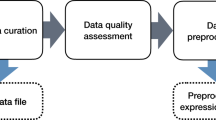Abstract
As the production and usage of nanomaterials increase, there are growing concerns on the unidentified detrimental effect of nanoparticles on human health and environmental safety. Systematic assessments of the risks associated with exposure to nanoparticles are needed. DNA microarrays have emerged as a powerful tool for toxicology research. Microarraybased toxicogenomics research provides valuable information for understanding underling mechanisms of toxicological behavior of non-classic contaminants, including ultrafine nanoparticles. In this work, we investigated the effect of nano-titanium oxide exposure on human cells by analyzing the change in transcription levels of cellular DNA. Cross-experimental analysis of heterogeneous gene expression datasets was performed using the RankProd algorithm. Multiple gene expression omnibus series obtained from various experimental conditions were combined and used for risk assessment. Several commonly regulated genes were identified as being unaffected by the laboratory specific conditions. Pathway analysis revealed the genes as being associated with six major pathways: arachidonic acid metabolism, purine metabolism, pentose phosphate pathway, mitogen-activated protein kinase signaling pathway, synthesis and degradation of ketone bodies, and methionine metabolism. The identified differently expressed genes provide a robust set of markers for exposure analysis and risk assessment of titanium oxide nanoparticles.
Similar content being viewed by others
References
Dowling, A. et al. Nanoscience and nanotechnologies: opportunities and uncertainties. Royal Soc Royal Acad Engin (2004).
Yang, F. M. et al. Effect of nano-packing on preservation quality of fresh strawberry (Fragaria ananassa Duch. cv Fengxiang) during storage at 4 degrees C. J Food Sci 75:C236–C240 (2010).
Titball, R. W. et al. Biosafety and selectable markers. Ann New York Acad Sci 1105:405–417 (2007).
Rahman, Q. et al. Evidence that ultrafine titanium dioxide induces micronuclei and apoptosis in Syrian hamster embryo fibroblasts. Environ Health Perspect 110: 797–800 (2002).
Wang, J. J., Sanderson, B. J. & Wang, H. Cyto- and genotoxicity of ultrafine TiO2 particles in cultured human lymphoblastoid cells. Mut Res/Genet Toxicol Environ Mutagen 628:99–106 (2007).
Long, T. C. et al. Nanosize titanium dioxide stimulates reactive oxygen species in brain microglia and damages neurons in vitro. Enviro Health Perspect 115: 1631–1637 (2007).
Gurr, J. R. et al. Ultrafine titanium dioxide particles in the absence of photoactivation can induce oxidative damage to human bronchial epithelial cells. Toxicology 213:66–73 (2005).
Lee, K. P., Trochimowicz, H. J. & Reinhardt, C. F. Pulmonary response of rats exposed to titanium dio-xide (TiO2) by inhalation for two years. Toxicol Appl Pharmacol 79:179–192 (1985).
Park, H. O. et al. Comparison of cellular effects of titanium dioxide nanoparticles with different photocatalytic potential in human keratinocyte, HaCaT cells. Mol Cell Toxicol 7:67–75 (2011)
Kim, J. S. et al. Array2KEGG: Web-based tool of KEGG pathway analysis for gene expression profile. BioChip J 4:134–140 (2010).
Barrett, T. et al. NCBI GEO: mining tens of millions of expression profiles-database and tools update. Nucl Acids Res 35:D760–D765 (2007).
Edgar, R., Domrachev, M. & Lash, A. E. Gene Expression Omnibus: NCBI gene expression and hybridization array data repository. Nucl Acids Res 30:207–210 (2002).
Craigon, D. J. et al. NASCArrays: a repository for microarray data generated by NASC’s transcriptomics service. Nucl Acids Res 32:D575–D577 (2004).
Brazma, A. et al. ArrayExpress-a public repository for microarray gene expression data at the EBI. Nucl Acids Res 31:68–71 (2003).
Ikeo, K., Ishi-i, J., Tamura, T., Gojobori, T. & Tateno, Y. CIBEX: Center for Information Biology gene Expression database. Comptes Rendus Biologies 326: 1079–1082 (2003).
Jung, K. H. et al. Decreased expression of TFF2 and gastric carcinogenesis. Mol Cell Toxicol 6:261–269 (2010).
Hong, F. et al. RankProd: a bioconductor package for detecting differentially expressed genes in meta-analysis. Bioinformatics 22:2825–2827 (2006).
Breitling, R. & Herzyk, P. Biological master games: using biologists’ reasoning to guide algorithm development for integrated functional genomics. OMICS 9: 225–232 (2005).
Pan, Z. et al. Adverse effects of titanium dioxide nanoparticles on human dermal fibroblasts and how to protect cells. Small 5:511–520 (2009).
Xia, T. et al. Comparison of the abilities of ambient and manufactured nanoparticles to induce cellular toxicity according to an oxidative stress paradigm. Nano Lett 6:1794–1807 (2006).
Yim, W. C. et al. Identification of novel 17β-estradiol (E2) target genes using cross-experiment gene expression datasets. Toxicol Env Health Sci 2:25–38 (2010).
Yim, W. C. et al. Cross experimental analysis of microarray gene expression data from volatile organic compounds treated targets. Mol Cell Toxicol 7:233–241 (2011).
Lempicki, R. A. et al. The DAVID gene functional classification tool: a novel biological module-centric algorithm to functionally analyze large gene lists. Genome Biol 8:R183 (2007).
Ashburner, M. et al. Gene ontology: tool for the unification of biology. Nat Genet 25:25–29 (2000).
Bindea, G. et al. ClueGO: a Cytoscape plug-in to decipher functionally grouped gene ontology and pathway annotation networks. Bioinformatics 25:1091–1093 (2009).
Eyre, T. A. et al. The HUGO Gene nomenclature database, 2006 updates. Nucl Acids Res 34:D319–D321 (2006).
Shannon, P. et al. Cytoscape: a software environment for integrated models of biomolecular interaction networks. Genome Res 13:2498–2504 (2003).
Galon, J. et al. ClueGO: a Cytoscape plug-in to decipher functionally grouped gene ontology and pathway annotation networks. Bioinformatics 25:1091–1093 (2009).
Author information
Authors and Affiliations
Corresponding author
Rights and permissions
About this article
Cite this article
Yim, W.C., Lee, BM. & Kwon, Y. Cross-experimental analysis of microarray gene expression datasets for in silico risk assessment of TiO2 nano-particles. Mol. Cell. Toxicol. 8, 229–239 (2012). https://doi.org/10.1007/s13273-012-0028-2
Received:
Accepted:
Published:
Issue Date:
DOI: https://doi.org/10.1007/s13273-012-0028-2




